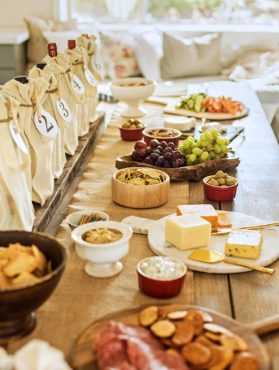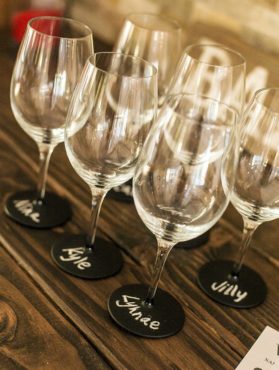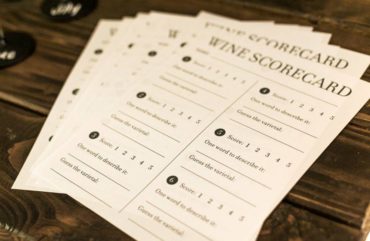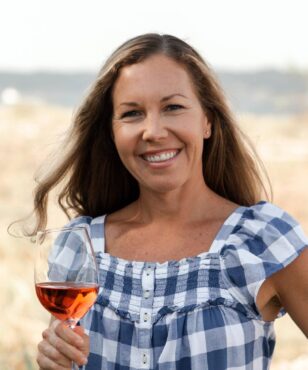 Wine, food and music. These are the key elements of any great party and as the height of party season, you’ll want to get your party A game dialed in.
Wine, food and music. These are the key elements of any great party and as the height of party season, you’ll want to get your party A game dialed in.
First and foremost is wine. Select a few different bottles to complement the food you’ll be serving as well as to provide enough variety, so everyone can have a glass of what they enjoy drinking.
Sparkling wine is always a fun way to kick off any party. Drop a few strawberries or cranberries in the bottom of a Champagne flute, fill with any sparkling wine and have glasses sitting on trays to greet guests right as they walk in the door. If your guests are close friends, you’ll likely know what they like to drink, so stock up on their favorites.
If you’ve got a group of adventuresome palates, try to provide some wines that are interesting and unique, which will also serve as a great conversation piece.
One of my favorite holiday party ideas is a blind wine tasting. Follow these steps to create a unique party where the wine shines and the conversation flows.
To get everyone participating, have each guest bring a bottle of wine. You can pick a theme such as Old World, New World, specific varietals or simply all whites or all reds. You may want to set a price limit on the wine or have each guest bring a bottle of favorite wine to share.
 As guests arrive, place their wine in a plain, brown paper bottle bag. Once all the wines have arrived, mix them up and number them on the outside of the bags. Provide each guest with a glass and start by serving wine No. 1 to everyone. Have the guests discuss what they smell, see and taste. If you’ve got some more discerning palates in your group, it’s fun to have them guess what kind of wine it is.
As guests arrive, place their wine in a plain, brown paper bottle bag. Once all the wines have arrived, mix them up and number them on the outside of the bags. Provide each guest with a glass and start by serving wine No. 1 to everyone. Have the guests discuss what they smell, see and taste. If you’ve got some more discerning palates in your group, it’s fun to have them guess what kind of wine it is.
Continue to taste each wine blind (not knowing what kind of wine is in each bag), discuss and guess. To limit over-consumption, provide a dump bucket for guests to discard any wine they don’t want to finish. Small pours are all you need to be able to smell, see and taste the wine.
This type of party is a great way to get guests talking, connecting with each other and learning something new. If you want to really geek out and go to the next level, you can provide tasting sheets for your guests to write their thoughts and really evaluate each wine. Make sure you have great music and lots of yummy food available during your tasting.
To more thoroughly evaluate a wine, try and identify the five basic characteristics:
- Sweetness
- Acidity
- Tannin
- Alcohol
- Body
The first impression of wine is often its sweetness. You pick up sweetness on the tip of the tongue and the more residual sugar (the natural grape sugars that are left over after fermentation) in the wine, the sweeter it will taste.
 Acidity is that puckering feeling you get on the sides of the mouth and in your cheeks. Acidity in wine can taste tart or zesty and you will feel a tingling sensation on the front and sides of your tongue. Wines with higher acidity feel lighter-bodied because they come across as spritzy. If you prefer a wine that is more rich and round, you enjoy slightly lower acidity.
Acidity is that puckering feeling you get on the sides of the mouth and in your cheeks. Acidity in wine can taste tart or zesty and you will feel a tingling sensation on the front and sides of your tongue. Wines with higher acidity feel lighter-bodied because they come across as spritzy. If you prefer a wine that is more rich and round, you enjoy slightly lower acidity.
Tannins taste dry and astringent and you can feel it on the middle of your tongue and the front part of your mouth. Grape tannin comes from the skins, seeds and stems of a wine. Tannin makes your tongue dry out and after you swallow, you feel a lingering, bitter or dry feeling in your mouth.
Alcohol is sensed toward the back of the mouth in the throat as a warming sensation. Wines with higher alcohol tend to taste bolder and oilier and wines with lower alcohol tend to taste lighter-bodied.
Body in a wine can range from light to full and is the perception of the weight of the wine on your tongue. Think of nonfat vs. whole milk. Nonfat milk is lighter and has less weight on your tongue than whole milk. You can pick up a similar sensation in light- and full-bodied wines.
These five elements together will have you tasting and enjoying wine in a whole new way. Remember these elements next time you attend or throw a party this holiday season.

























